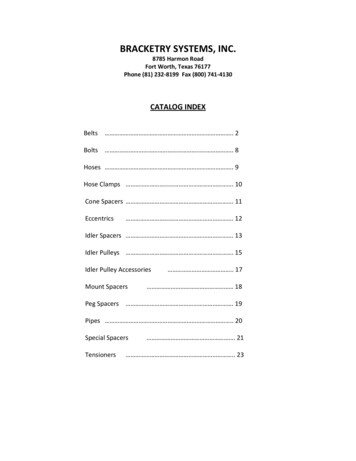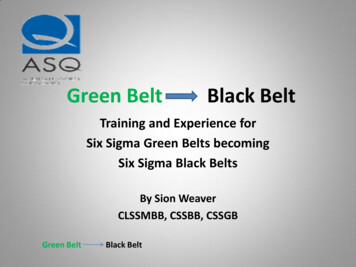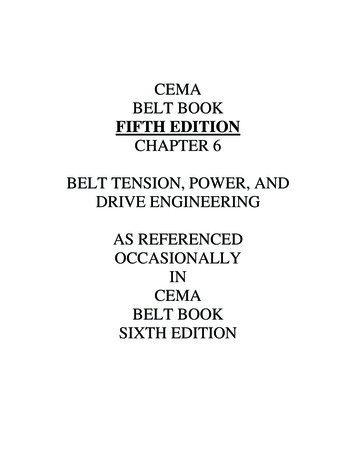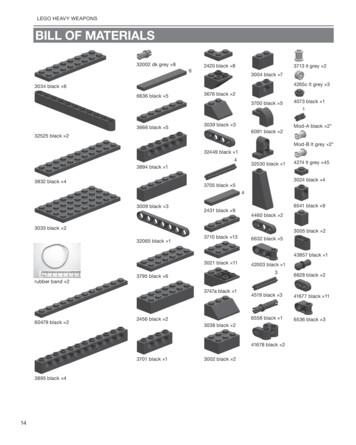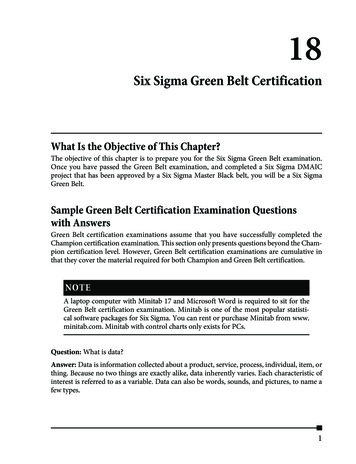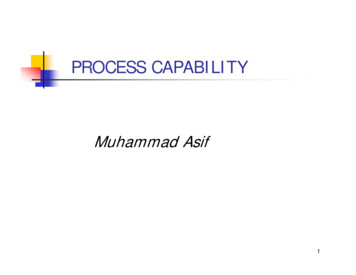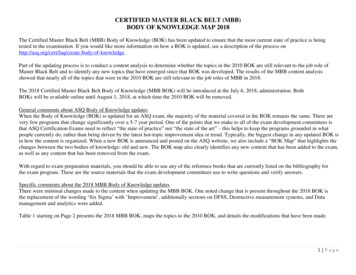
Transcription
CERTIFIED MASTER BLACK BELT (MBB)BODY OF KNOWLEDGE MAP 2018The Certified Master Black Belt (MBB) Body of Knowledge (BOK) has been updated to ensure that the most current state of practice is beingtested in the examination. If you would like more information on how a BOK is updated, see a description of the process .Part of the updating process is to conduct a content analysis to determine whether the topics in the 2010 BOK are still relevant to the job role ofMaster Black Belt and to identify any new topics that have emerged since that BOK was developed. The results of the MBB content analysisshowed that nearly all of the topics that were in the 2010 BOK are still relevant to the job roles of MBB in 2018.The 2018 Certified Master Black Belt Body of Knowledge (MBB BOK) will be introduced at the July 6, 2018, administration. BothBOKs will be available online until August 1, 2018, at which time the 2010 BOK will be removed.General comments about ASQ Body of Knowledge updatesWhen the Body of Knowledge (BOK) is updated for an ASQ exam, the majority of the material covered in the BOK remains the same. There arevery few programs that change significantly over a 5-7 year period. One of the points that we make to all of the exam development committees isthat ASQ Certification Exams need to reflect “the state of practice” not “the state of the art” – this helps to keep the programs grounded in whatpeople currently do, rather than being driven by the latest hot-topic improvement idea or trend. Typically, the biggest change in any updated BOK isin how the content is organized. When a new BOK is announced and posted on the ASQ website, we also include a “BOK Map” that highlights thechanges between the two bodies of knowledge: old and new. The BOK map also clearly identifies any new content that has been added to the exam,as well as any content that has been removed from the exam.With regard to exam preparation materials, you should be able to use any of the reference books that are currently listed on the bibliography forthe exam program. These are the source materials that the exam development committees use to write questions and verify answers.Specific comments about the 2018 MBB Body of Knowledge updatesThere were minimal changes made to the content when updating the MBB BOK. One noted change that is present throughout the 2018 BOK isthe replacement of the wording ‘Six Sigma’ with ‘Improvement’, additionally sections on DFSS, Destructive measurement systems, and Datamanagement and analytics were added.Table 1 starting on Page 2 presents the 2018 MBB BOK, maps the topics to the 2010 BOK, and details the modifications that have been made.1 Page
Table 1. 2018 MBB BOK mapped to the 2010 MBB BOK2010BOKI.1.A1.B1.C1.D2018 BOK DetailsEnterprise-wide Planning (20 questions)A. Strategic plan developmentDescribe and use strategic planning tools and methods such as Hoshin Kanri, X Matrix, SWOT,PEST, PESTLE, Ansoff Matrix, Porter’s Five Forces, TQM, Business Process Reengineering,Balanced Scorecard, and business excellence models (Baldridge, EFQM, ISO, Shingo) and theirutilization in developing enterprise planning. (Apply)B. Strategic plan alignment1. Strategic deployment goalsDescribe how to develop strategic deployment goals. (Apply)2. Project alignment with strategic planDescribe how to align projects to the organizational strategic plan. (Analyze)3. Project alignment with business objectivesDescribe how to align projects with business objectives. (Analyze)C. Infrastructure elements of improvement systemsDescribe how to apply the following key infrastructure elements. (Apply)1. Governance (quality councils or process leadership teams)2. Assessment (organizational readiness and maturity models)3. Resource planning (identify candidates and costs/benefits)4. Resource development (train and coach)5. Execution (deliver on project results)6. Measure and improve the system (drive improvement into the systems, multiphaseplanning)D. Improvement methodologiesDemonstrate an advanced understanding of the following methodologies, including theirassociated tools and techniques. (Apply)1. Six Sigma (DMAIC)2. Design for Six Sigma (DMADV)3. Lean (PDCA, Kaizen)4. Theory of Constraints5. Business systems and process management6. Other problem solving methods (8 disciplines, root cause analysis)New Elements in2018 BOKRenamed sectionand decrease inquestions by 5Expanded list oftools in subtext.Increasedcognitive levelsof B2 and B3from Apply toAnalyze.Renamed sectionRenamed section,revised andexpanded list ofmethodologies.2 Page
1.E1.FE. Opportunities for improvement1. Project identificationFacilitate working sessions to identify new project opportunities that can be prioritized.(Apply)2. Project qualificationDetermine the elements of a well-defined project (e.g., business case, charter), the processfor approving these projects, and tools used in project definition (process maps, valuestream maps, QFD, FMEA, Critical-To-x (CTx where x can be customer, design, cost, andquality). (Apply)3. Stakeholder managementDescribe how to identify, engage and strategically align stakeholders. (Analyze)4. Intervention techniquesDescribe techniques for intervening across levels to prevent potential project failures.(Apply)5. Creativity and innovation toolsUse creativity and innovation tools to develop concept alternatives (divergent thinking).(Apply)F. Pipeline management1. Pipeline creationCreate, manage, and prioritize a pipeline of potential projects for consideration. (Create)2. Pipeline lifecycle managementCreate a selection process that provides a portfolio of active improvement opportunitiesthat are clearly aligned and prioritized to meet/exceed strategic goals. Monitor, re-evaluate,consolidate, and retire pipelines as needed. (Create)3. Regulatory impact on pipelineAssess the impact of regulatory statutes on prioritization/management of pipeline ofpotential projects. (Understand)4. Pipeline risk managementUse risk management and analysis tools to analyze organizational elements, to appraiseportfolios and critical projects, and to identify potential problem areas. (Evaluate)Renamed sectionand cognitivelevel of 1.E.3changed fromApply toAnalyze.Renamed sectionheading, reordered andrenamed subtopics and addedF3.3 Page
2010BOK2018 BOK DetailsII.1.G.11.G.22.C2.BOrganizational Competencies for Deployment (20 questions)A. Organizational design1. Systems thinkingApply systems thinking to anticipate the effect that components of a system can have onother subsystems and adjacent systems including emergent properties. Analyze the impactof actions taken in one area of the organization and how those actions can affect other areasor the customer, and use appropriate tools to prevent unintended consequences. (Analyze)2. Organizational culture and maturityDescribe the implications organizational culture and maturity levels can have onimprovement program implementation, including potential barriers. (Analyze)B. Executive and team leadership roles1. Executive leadership rolesDescribe the roles and responsibilities of executive leaders in the deployment ofimprovement programs in terms of providing resources, managing change, andcommunicating ideas. (Analyze)2. Leadership for deploymentCreate action plans to support optimal functioning of master black belts, black belts, greenbelts, champions, and other participants in the deployment effort. Design, coordinate, andparticipate in deployment activities, and ensure that project leaders and teams have therequired knowledge, skills, abilities, and attitudes to support the organization’simprovement program. (Create)C. Organizational challenges1. Organizational dynamicsUse knowledge of human and organizational dynamics to enhance project success and aligncultural objectives with organizational objectives. (Apply)2. Intervention stylesUse appropriate intervention, communications, and influence styles, and adapt those stylesto specific situations (i.e., situational leadership). (Apply)3. Interdepartmental conflictsAddress and resolve potential situations that could cause the program or a project to underperform. (Apply)Increase inquestions by 5Increasedcognitive level of1.G.2 fromUnderstand toAnalyze.Moved from 2.CRenamed section4 Page
1.H.1.G.32.A1.ID. Organizational change management1. Change management modelsDescribe different change management models (Kotter’s 8-Step, ADKAR, CompetingValues Framework). (Apply)2. Techniques to gain commitmentDescribe how to gain commitment from the organization’s leadership for the improvementeffort. (Understand)3. Techniques to overcome organizational barriersDescribe various techniques to overcome barriers to successful organizational deployment.(Apply)4. Necessary organizational structure for deploymentDevelop the inherent organizational structure needed for successful deployment. (Apply)5. Communications with managementDescribe elements of effective communications with management regarding organizationalbenefits, failures, and lessons learned. (Apply)6. Organizational culture change techniquesAssess culture of the organization and its ability to problem-solve and improve. Describetechniques for changing an organizational culture, such as rewards and recognition, teamcompetitiveness, communications of program successes, and appropriate cascading of goalsthroughout the organization. (Apply)E. Organizational feedback1. Voice of the customer and voice of the processAssess the appropriate collection of Voice of the Customer and Voice of the Process data,both internal and external. (Evaluate)2. Capturing and assessing feedbackDevelop a customer-focused strategy for capturing and assessing customer feedback on aregular basis. (Evaluate)F. Organizational performance metrics1. Financial measuresDefine and use financial measures, including revenue growth, market share, margin, cost ofquality (COQ), net present value (NPV), return on investment (ROI), cost-benefit analysis,activity-based cost analysis, direct costs, indirect costs and opportunity cost, project cashflow, and breakeven time performance. (Analyze)2. Business performance measuresRenamed section,renamed subtopic D.1.,combined 1.Hand 1.G.3Renamed sectionand broke subtextinto two subtopics.Renamed sectionand consolidatedsubtext from 4sub-topics into 2,removedSarbanes-OxleyAct.5 Page
Describe various business performance measures, including Balanced Scorecard, keyperformance indicators (KPIs), and the financial impact of customer loyalty, and describehow they are used for project selection, deployment, and management. (Analyze)2010BOK2018 BOK DetailsIII.3.B3.A3.B3.CBOKProject Portfolio Management (15 questions)A. Project management principles and lifecycle1. Project management principlesOversee critical projects and evaluate them in terms of their scope, goals, time, cost,quality, human resources requirements, communications needs, and risks. (Evaluate)2. Project management lifecycle elementsApply phases of project management lifecycle (Initiation, Planning, Execution, Control andClosure). (Analyze)B. Project portfolio infrastructure and management1. Governance methods and toolsDevelop governance documents, tracking tools, and other methodologies that will supportproject success. (Create)2. Cross-functional project assessmentAppraise interrelated projects for scope overlap and refinement, and identify opportunitiesfor leveraging concomitant projects. Identify and participate in the implementation ofmulti-disciplinary redesign and improvement projects. (Evaluate)3. Executive and mid-level management engagementFormulate the positioning of multiple projects in terms of providing strategic advice to topmanagement and affected mid-level managers. (Create)4. PrioritizationPrioritize projects in terms of their criticality to the organization. (Evaluate)5. Performance measurementDesign, support, and review the development of an overall measurement methodology torecord the progress and ongoing status of projects and their overall impact on theorganization. (Evaluate)6. MonitoringApply appropriate monitoring and control methodologies to ensure that consistent methodsare used in tracking tasks and milestones. (Analyze)Renamed section3.B.2 newcontentRenamed sectionand combined3.A, B and C,revised subtext,sub-topic names,and cognitivelevels. 3.B.2Analyze toEvaluate, 3.B.4Apply toEvaluate, 3.B.6Apply toAnalyze, 3.B.9Apply toAnalyze.6 Page
7. Status communicationDevelop and maintain communication techniques that will keep critical stakeholders andcommunities apprised of project status, results, and accountability. (Create)8. Supply/Demand managementGenerate accurate project supply/demand projections, associated resource requirementsanalysis, and mitigate any issues. (Create)9. Corrective actionFacilitate corrective actions and responses to customers about the corrective action and itsimpact. (Analyze)C. Project portfolio financial tools1. Budgets and forecastsAssess and explain budget implications, forecasting, measurement, monitoring, riskanalysis, and prioritization for portfolio level projects. (Evaluate)2. Costing conceptsDefine the concepts of hard and soft dollars and use cost of poor quality, activity-basedcosting, and other methods to assess and prioritize portfolios. (Apply)3.D2010BOK2018 BOK DetailsIV.4.A4.B4.CRenamed sectionTraining Design and Delivery (10 questions)A. Training needs analysisAssess the current level of knowledge and skills in each target group in relation to the skills andabilities that are needed. Conduct a gap analysis to determine the training needs for each targetgroup. (Evaluate)B. Training plan elementsDesign training plans to close the knowledge and skills gaps. Refine the plans based on thenumber of people needing to be trained in a particular technique or skill, and whether multidisciplinary or multi-level competency training is appropriate. (Create)C. Training materials and curriculum development1. Training material sourcesDetermine whether to outsource the training or develop in house, including considerationssuch as cost, availability of internal subject matter experts, and timing. (Analyze)2. Adult learning theoryDevelop or select training methods and resources that adhere to adult learning theories.(Analyze)3. IntegrationRenamed sectionAdded 4.C.17 Page
Ensure that the training harmonizes and leverages other tools and approaches being usedand that it is aligned with the organization’s strategic objectives and culture. (Evaluate)4. Training deliveryMonitor and measure training to ensure that it is delivered effectively and efficiently byqualified individuals. (Apply)D. Training program effectivenessDevelop an evaluation plan to assess, verify, and improve the acquisition of requiredknowledge and skills within schedule, budget, and other constraints. (Create)4.D2010BOK2018 BOK DetailsV.5.A5.B5.CRenamed andexpanded subtext.Coaching and Mentoring Responsibilities (10 questions)A. Executives and champions1. Scoping and resourcingCollaborate with executives and champions on scoping projects and selecting individualsand assignments for various projects. (Evaluate)2. Executive reviewsCollaborate with executives and champions on reviewing projects, including timing,questions to ask, and setting expectations for project timing and completion. (Create)3. Leadership and communicationCoach executives and champions on the need for constancy of purpose and message, andthe importance of using clear communication techniques and consistent messages.(Evaluate)4. FeedbackUse constructive techniques to provide feedback to champions and executives. (Evaluate)B. Teams and individuals1. Belt coaching and mentoringDevelop a career progression ladder for belts. Assess their progress and provideconstructive feedback to enable them to work effectively on team projects. Use coaching,mentoring, and intervention skills as needed, including canceling or reassigning projects ifnecessary. (Create)2. Project reviewsCreate guidelines and expectations for project reviews, and perform them in a timelymanner. Assist project leaders in selecting appropriate content for presentation tomanagement. (Create)3. Team facilitation and meeting managementRevised sectionnameRenamed subsection 5.A aswell as 5.A.1, 2and 3. Re-ordered5.A.1 and 5.A.2.Revised cognitivelevel of5.A.1from Createto Evaluate, and5.A.2 fromEvaluate toCreate.Renamed subtopic 5.B as wellas 5.B.1 and 2.Added section5.C. Revisedcognitive level of5.B.1 and 5.B.4from Evaluate toCreate.8 Page
Practice and teach meeting control, analyze team performance at various stages of teamdevelopment, and support appropriate interventions for overcoming team challenges,including floundering, reviewing and diagnosing failing projects. (Create)4. Non-belt coaching and mentoringDevelop information that will help non-belt project participants to advance theirunderstanding of improvement initiatives and develop the necessary skills and knowledgeto become effective belts. (Evaluate)2010BOK2018 BOK DetailsVI.6.A6.D6.BAdvanced Data Management and Analytic Methods (25 questions)A. Measurement systems analysis (MSA), process capability and control1. Propagation of errorsUse propagation of errors to evaluate measurement systems based on calculated valuesfrom multiple inputs. (Evaluate)2. Attribute (discrete) measurement systemsUse appropriate tools and methods (e.g., percent agreement, Kappa, Kendall, intra-classcorrelation coefficient) to analyze and interpret discrete measurement systems. (Evaluate)3. Variables (continuous) measurement systemsUse appropriate tools and methods (e.g., X R , X s , individual and moving range) basedon control samples to analyze and interpret continuous measurement systems. (Evaluate)4. Destructive measurement systemsUse appropriate tools and methods to assess a destructive measurement system. (Analyze)5. Process capability for non-normal dataCalculate capability using Weibull and other methods for non-normal data. (Apply)6. Automated process control (APC) and statistical process control (SPC)Recognize when to use APC instead of or in conjunction with SPC. (Understand)B. Measuring and modeling relationships between variables1. Autocorrelation and forecastingIdentify autocorrelation, including time-series modeling (e.g., ARIMA) and forecasting.(Analyze)2. Multiple regression analysisApply and interpret multiple regression analysis, including using variance inflation factors(VIFs) to identify collinearity issues. (Analyze)3. Logistic regression analysisRevised sectionnameRevised sectionname and addednew contentsection 6.A.4.,and moved 6.D tothis section.Revised cognitivelevel of 6.B.1from Understandto Analyze, 6.B.2from Apply toAnalyze, and6.B.3 from Applyto Analyze.9 Page
6.CApply and interpret logistic regression analysis, including binary, ordinal, and nominal dataconsiderations. (Analyze)4. Model fitting for non-linear modelsApply and interpret fits of models that are non-linear in the parameters. (Apply)5. General linear models (GLM)Apply and interpret GLMs such as ANOVA results (crossed, nested, and mixed models),simple linear regression, multiple regression, ANCOVA (analysis of covariance) andcontinuous MSA. (Apply)6. Components of variationSelect, calculate, and interpret components of variation and nested design studies.(Evaluate)7. SimulationApply simulation tools such as Monte Carlo, dynamic process simulation, and queuingtheory. (Apply)8. Linear programmingUnderstand how linear programming principles, such as critical path analysis, can be usedin modeling diverse types of problems (e.g., planning, routing, scheduling, assignment,design) to optimize system performance. (Understand)9. Reliability modelingUse reliability modeling and tools to enhance reliability of a product or process. (Apply)10. Qualitative analysisUse appropriate qualitative analysis tools (affinity diagrams, force field analysis) andanalyze the results. (Analyze)C. Design of Experiments (DOE)1. Factor relationship diagramApply and interpret factor relationship diagrams. (Apply)2. Complex blocking structuresRecognize other designs for handling more complex blocking structures, including LatinSquares and balanced incomplete block designs (BIBD). (Understand)3. DOE approachesRecognize when to apply approaches such as screening designs (including DefinitiveScreening Designs), response surface methodology (RSM), mixture experiments,evolutionary operations (EVOP), split-plot designs, Taguchi designs and computergenerated designs (e.g. D-optimal designs). (Understand)Revised name ofsection 6.C.1,added LatinSquares. Revisedname of section6.C.3.10 P a g e
NewSection1.D2010BOKPB-1PB-2PB-3D. Data management and analytics1. Enterprise data managementRecognize and understand data management elements such as data governance, dataarchitecture, data lifecycle management, data quality (accuracy, timeliness, consistency,completeness, uniqueness, validity, conformity, precision), meta data, master data, dataprivacy and data security. (Understand)2. Data analyticsRecognize when to apply predictive analytic approaches such as decision trees (includingrandom forest, boosted forest), neural networks, partial least squares, text analytics, imagerecognition and pattern recognition (structured and unstructured data). (Understand)New sectionE. DFSS (Design for Six Sigma)DFSS toolsRecognize and understand tools such as QFD, TRIZ, morphology box, and axiomaticdesign to generate design concepts. (Understand)Moved fromsection 1.D andexpanded andcognitive levelchanged fromApply toUnderstand.2018 BOK DetailsASQ Certified Master Black Belt (MBB) Body of KnowledgePerformance-Based Section Essay ResponsePB-1. Enterprise-wide PlanningApply project selection criteria to select and prioritize potential improvement projects using strategicplanning tools, immediate- and long-term business goals, executive-level directives, and risk analysis results.Develop and deliver formal presentations that support the project selection process, identify progress, andexplain its status at conclusion.PB-2. Organizational Competencies for DeploymentUse feedback and process data from various sources to identify or develop improvement projects that willrespond to customer needs, eliminate process barriers, or streamline processes, especially for managingprojects that cross boundaries either within or between organizations. Use appropriate communicationmethods that are sensitive to specific audiences when explaining projects or solutions, encouragingparticipation, or resolving issues that arise between interorganizational groups.PB-3. Project Portfolio ManagementDevelop and manage the scope, schedule, cost, and risk of improvement projects using various projectmanagement tools to ensure proper monitoring, milestone achievement, and project success. RecognizeRenamed sectionand revisedsubtextRenamed sectionand revisedsubtextRenamed section11 P a g e
PB-4when intervention steps must be taken to bring a project back on track or terminate it based on analysis ofinternal or external events.PB-4. Training, Coaching and MentoringIdentify situations that require training or mentoring for all levels of participants in improvement projects,from executive level champions to non-belt participants. Develop, review, and deliver information,training, or mentoring as needed for a variety of improvement projects, based on needs analysis,participant requests, or recognition of situations that require intervention.Renamed section12 P a g e
The 2018 Certified Master Black Belt Body of Knowledge (MBB BOK) will be introduced at the July 6, 2018, administration. Both BOKs will be available online until August 1, 2018, at which time the 2010 BOK will be removed. General comments about ASQ Body of Knowledge updates

